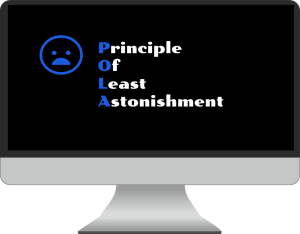Principle of Least Astonishment (POLA): Designing Predictable Code

The Principle of Least Astonishment (POLA) is a key guideline in software design and development, emphasizing that code and systems should behave in a predictable manner that aligns with the expectations of their users or developers. When code surprises someone by behaving unexpectedly, it can lead to confusion, frustration, and errors. POLA helps ensure that systems are intuitive, reducing the cognitive load required to understand or use them.
What Is the Principle of Least Astonishment?
POLA states that a system or piece of code should act in the way a user or developer intuitively expects. The goal is to avoid surprising behavior, especially in situations where such behavior could cause confusion or mistakes. This principle applies to all aspects of software, from user interfaces to APIs and internal code structures.
Key Characteristics of POLA
1. Intuitiveness
Code should feel natural to developers, following conventions and practices familiar to its audience. Intuitive code requires little explanation or documentation to understand and use effectively.
2. Consistency
Consistency is a cornerstone of POLA. Functions, classes, and APIs should behave consistently across similar contexts. Inconsistent behavior can confuse users and developers, violating their expectations.
3. Predictability
The behavior of code should be easy to predict based on its naming, structure, or documentation. Predictable code ensures developers feel confident using it without constant second-guessing or testing.
Benefits of POLA
1. Enhanced Usability
Code and systems that follow POLA are easier to use, making them accessible even to developers unfamiliar with the project. This increases productivity and reduces the learning curve.
2. Fewer Bugs
Surprising behavior often leads to errors. By ensuring code acts as expected, POLA minimizes the risk of misunderstandings that could introduce bugs.
3. Improved Collaboration
When multiple developers work on a project, POLA ensures they share a common understanding of how the code behaves. This fosters better communication and smoother collaboration.
How to Apply POLA
1. Follow Established Conventions
Adhere to language-specific or framework-specific conventions to make the code predictable for other developers. For example, in JavaScript, functions starting with “get” are generally expected to retrieve values without side effects.
2. Avoid Hidden Side Effects
Functions or methods should do what their names suggest and nothing more. For example, a method called calculateTotal should not also modify the database.
3. Provide Clear Feedback
When something unexpected occurs, such as an error, ensure the feedback is clear and actionable. Error messages should precisely describe the problem and how to fix it.
4. Test for Common Scenarios
Anticipate how users and developers are likely to interact with your code. Test these scenarios to ensure the behavior aligns with expectations.
Examples of Violating POLA
- Using non-standard terminology or naming conventions (e.g., calling a method
fetchDatabut having it delete records). - Inconsistent APIs, where similar methods behave differently under the same conditions.
- Implementing a feature that requires complex, non-intuitive configurations without providing clear documentation or defaults.
Conclusion
The Principle of Least Astonishment encourages developers to design systems and code that behave predictably and intuitively. By aligning behavior with expectations, POLA reduces confusion, improves usability, and minimizes errors. Whether designing a user interface, an API, or a backend system, adhering to POLA ensures a smoother experience for users and developers alike, leading to more reliable and maintainable software.